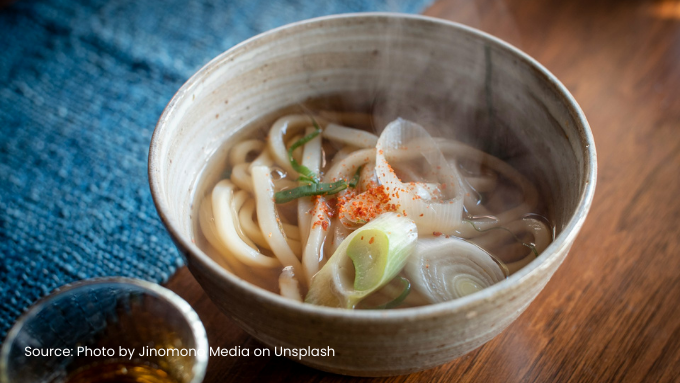Coconut Flour as Substitute in Noodle Formulation to Increase the Fiber Content

Downloads
Background: Non-communicable diseases can be prevented with dietary modifications, but major dietary changes are difficult for most people. One alternative that can be done is to add important nutrients in the form of a familiar diet menu, such as noodles. One of the nutrients that can help is fiber. One of the sources of fiber in Indonesia is coconut flour, which is a by-product of coconut oil and coconut milk.
Objectives: This study aims to determine the effect of coconut flour substitution on the acceptability of noodles and the fiber content of substituted noodles.
Methods: This study used a factorial design with Completely Randomized Design. The study was conducted with 30 untrained adult as panelists. Acceptability was measured by a preference test on 3 formulas consisting of a control formula without coconut flour substitution (F0), a substitution formula with a ratio of wheat flour to coconut flour 85%:15% (F1), a formula with a ratio of wheat flour to coconut flour 80% :20% (F2).
Results: The substitution of wheat flour with coconut flour in noodles F1 and F2 percent increased the fiber composition in noodles from 1.99g/100g to 5.98g/100g and 7.31g/100g. Substitution did not have a significant effect on the parameters of taste and aroma, but it did affect the decrease in the panelists' preference for the parameters of the color and elasticity of the noodles.
Conclusions: The conclusion obtained is that the substitution of coconut flour in noodles increases the fiber content in the substituted noodle formula and decreases the acceptability in terms of the elasticity and color of the substituted noodles. F1 formula appears to be the best formula, which has the highest acceptability among substitution formula
Afshin, A. et al. (2019) ‘Health effects of dietary risks in 195 countries, 1990–2017: a systematic analysis for the Global Burden of Disease Study 2017', The Lancet, 393(10184), pp. 1958–1972. doi: 10.1016/S0140-6736(19)30041-8.
Alouw, J. C. and Wulandari, S. (2020) ‘Present status and outlook of coconut development in Indonesia', IOP Conference Series: Earth and Environmental Science, 418(1). doi: 10.1088/1755-1315/418/1/012035.
Anderson, J. W. et al. (2009) ‘Health benefits of dietary fiber', Nutrition Reviews, 67(4), pp. 188–205. doi: 10.1111/j.1753-4887.2009.00189.x.
Aune, D. et al. (2016) ‘Whole grain consumption and risk of cardiovascular disease, cancer, and all cause and cause specific mortality: Systematic review and dose-response meta-analysis of prospective studies', BMJ (Online), 353, pp. 1–14. doi: 10.1136/bmj.i2716.
Badan Penelitian dan Pengembangan Kesehatan (2014) SURVEI KONSUMSI MAKANAN INDIVIDU INDONESIA 2014.
Chuwa, C. et al. (2020) ‘Food Fibres: A Solution to Combat Non-Communicable Diseases', Nutrition and Metabolism: An Open Access, 2018(01). doi: 10.29011/nmoa-105.100005.
Danaei, G. et al. (2009) ‘The preventable causes of death in the United States: Comparative risk assessment of dietary, lifestyle, and metabolic risk factors', PLoS Medicine, 6(4). doi: 10.1371/journal.pmed.1000058.
Farrand, C. et al. (2017) ‘Know your noodles! assessing variations in sodium content of instant noodles across countries', Nutrients, 9(6), pp. 1–10. doi: 10.3390/nu9060612.
Huh, I. S. et al. (2018) ‘Erratum: Instant noodle consumption is associated with cardiometabolic risk factors among college students in Seoul (Nutrition Research and Practice, (2017), 10.4162/nrp.2017.11.3.232)', Nutrition Research and Practice, 12(2), p. 173. doi: 10.4162/nrp.2018.12.2.173.
Jones, J. M. (2014) ‘CODEX-aligned dietary fiber definitions help to bridge the "fiber gap”', Nutrition Journal, 13(1), pp. 1–10. doi: 10.1186/1475-2891-13-34.
Kemenkes RI (2018) ‘Hasil Riset Kesehatan Dasar Tahun 2018', Kementrian Kesehatan RI, 53(9), pp. 1689–1699.
Kemenkes RI (2019) Angka Kecukupan Gizi. Peraturan Menteri Kesehatan RI No 28 Tahun 2019.
Kementerian Pertanian (2018) ‘Statistik Konsumsi Pangan Tahun 2018', Statistik Konsumsi Pangan, pp. 1–103. Available at: http://epublikasi.setjen.pertanian.go.id/arsip-perstatistikan/163-statistik/statistik-konsumsi/599-statistik-konsumsi-pangan-tahun-2018.
Koh, A. et al. (2016) ‘From dietary fiber to host physiology: Short-chain fatty acids as key bacterial metabolites', Cell, 165(6), pp. 1332–1345. doi: 10.1016/j.cell.2016.05.041.
Lattimer, J. M. and Haub, M. D. (2010) ‘Effects of dietary fiber and its components on metabolic health', Nutrients, 2(12), pp. 1266–1289. doi: 10.3390/nu2121266.
Pakhare, K. N., Dagadkhair, A. C. and Udachan, I. S. (2018) ‘Enhancement of Nutritional and Functional Characteristics of Noodles by Fortification with Protein and Fiber: A Review', Journal of Pharmacognosy and Phytochemistry, 7(1), pp. 351–357.
Shirai, S. S. et al. (2021) ‘Identifying Ingredient Substitutions Using a Knowledge Graph of Food', Frontiers in Artificial Intelligence, 3(January), pp. 1–10. doi: 10.3389/frai.2020.621766.
Spring, B. et al. (2012) ‘Multiple behavior changes in diet and activity: A randomized controlled trial using mobile technology', Archives of Internal Medicine, 172(10), pp. 789–796. doi: 10.1001/archinternmed.2012.1044.
Tarigan, T. Y. et al. (2015) ‘PEMANFAATAN TEPUNG KELAPA DALAM PEMBUATAN MI KERING UTILIZATION OF COCONUT FLOUR TO MAKING DRY NOODLE', Junal Online Mahasiswa Fakutas Pertanian, 2(2).
Trinidad, T. P. et al. (2006) ‘Dietary fiber from coconut flour: A functional food', Innovative Food Science and Emerging Technologies, 7(4), pp. 309–317. doi: 10.1016/j.ifset.2004.04.003.
U.S. Department of Agriculture (2017) Food Data Central : Coconut Flour. Available at: https://fdc.nal.usda.gov/fdc-app.html#/food-details/2012839/nutrients.
Yu, E., Malik, V. S. and Hu, F. B. (2018) ‘Cardiovascular Disease Prevention by Diet Modification: JACC Health Promotion Series', Journal of the American College of Cardiology, 72(8), pp. 914–926. doi: 10.1016/j.jacc.2018.02.085.
Copyright (c) 2024 Sekarsari Nuraini, Bambang Wirjatmadi

This work is licensed under a Creative Commons Attribution-ShareAlike 4.0 International License.
Media Gizi Kesmas by Unair is licensed under a Creative Commons Attribution-ShareAlike 4.0 International License.
1. The journal allows the author(s) to hold the copyright and to retain the publishing right of the article without restrictions.
2. The legal formal aspect of journal publication accessibility refers to Creative Commons Attribution-Share-Alike (CC BY-SA).
3. The Creative Commons Attribution-Share-Alike (CC BY-SA) license allows re-distribution and re-use of a licensed work on the conditions that the creator is appropriately credited and that any derivative work is made available under "the same, similar or a compatible license”. Other than the conditions mentioned above, the editorial board is not responsible for copyright violations.



















